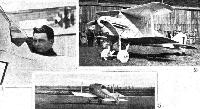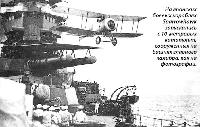
Варианты
- Nieuport & General - Nighthawk - 1918 - Великобритания
- Gloster - Mars (Bamel) / Nighthawk / Sparrowhawk - 1921 - Великобритания
Gloster Mars I
Компания "Gloucestershire Aircraft Company" была образована в середине 1917 года, а в конце 1926 года переименована в "Gloster Aircraft Company".
Отсутствие крупных заказов после окончания Первой мировой войны привело руководство компании к решению убедить британское Министерство авиации в том, что именно "Gloster" является единственной авиастроительной компанией, способной проектировать и строить скоростные истребители. С этой целью в компании был спроектирован одноместный гоночный самолет, названный "Bamel" и рассматривавшийся в качестве прототипа перспективных скоростных истребителей. Самолет представлял собой совершенный, с точки зрения аэродинамики, биплан, оснащенный одностоечной бипланной коробкой и получивший двигатель Napier Lion мощностью 450 л. с. (336 кВт). Недостатком являлась несколько неудобная конструкция носовой части, вмещавшая топливный и водяной баки, вследствие чего пилот из кабины практически ничего не видел впереди по курсу. Позже баки все же перенесли внутрь фюзеляжа.
Самолет совершил первый полет 20 июня 1921 года, а в следующем месяце на нем было завоевано первое место на ежегодных авиагонках Aerial Derby. Затем самолет подвергся некоторой доработке и 12 декабря 1921 года установил британский рекорд скорости - 316,10 км/ч. В 1922 году на данной машине вновь было завоевано первое место на гонках Aerial Derby.
ТАКТИКО-ТЕХНИЧЕСКИЕ ХАРАКТЕРИСТИКИ
Gloster Mars I
Тип: одноместный гоночный самолет
Силовая установка: один W-образный ПД Napier Lion мощностью 530 л. с. (395 кВт)
Летные характеристики: максимальная скорость на уровне моря 325 км/ч; набор высоты 3048 м - за 4 мин 15 с
Масса: пустого 857 кг; максимальная взлетная 1134 кг
Размеры: размах крыла 6,70 м; длина 7,01 м; высота 2,84 м; площадь крыльев 19,04 м1
Описание:
- Gloster Mars I
- Gloster Mars, Nighthawk, Nightjar и Sparrowhawk
- Flight, July 1921
THE WINNER OF THE DERBY
Фотографии
-
Aeroplane Monthly 1989-06 / K.Wixey - Folland's racers (1)
Регистрационный номер: G-EAXZ [13] The Winner of the Aerial Derby: The Mars I. Three-quarter front view. Note the position of the petrol tank on top of the fuselage, in front of the pilot's seat.
Gloster Bamel G-EAXZ at Hendon on July 16, 1921, about to compete in the Aerial Derby, which it won with an average speed of 163-3 m.p.h. The name Bamel was chosen by Folland before the aircraft was completed; “it was a cross between a bear and a camel, because the machine was nothing like a camel and the back part was not yet finished!" -
Flight 1921-12 / Flight
Регистрационный номер: G-EAXZ [13] The Mars I as it appeared in the Martlesham tests: Note the clean lines, and the manner in which the Napier ''Lion'' has been cowled in. Also the fairings behind the wheels.
-
Flight 1921-07 / Flight
Регистрационный номер: G-EAXZ [13] THE WINNER OF THE AERIAL DERBY: Two views of the Mars I.
-
Мировая Авиация 141
Регистрационный номер: G-EAXZ [13] Самолет Mars I изображен в своем первоначальном виде, он отличается хвостовым оперением по типу Nighthawk и неудобным размещением топливного и водяного баков.
-
Flight 1922-02 / Flight
Регистрационный номер: G-EAXZ [13] The "Mars I" of the Gloucestershire Aircraft Co. was greatly admired by visitors to Croydon.
-
Flight 1922-06 / Flight
Регистрационный номер: G-EAXZ [13] THE GLOUCESTERSHIRE "MARS I," 450 H.P. NAPIER "LION," AT WADDON: Mr. James's flying on this machine was greatly appreciated, and coming down wind the machine must have been doing about 210 m.p.h. A remarkable feature of the "Mars I" is its slow landing speed, which is actually no higher than that of some commercial passenger aeroplanes in regular use on the London-Paris service. Yet its maximum speed is in the neighbourhood of 195 m.p.h. in still air, and its climb is simply marvellous.
-
Aviation Historian 9 / R.Pegram - Folland's Forgotten Monoplanes (1)
Регистрационный номер: G-EAXZ [13] Folland's first design for the Gloucestershire Aircraft Company was the Mars I, given the nickname “Bamel”. The aircraft’s streamlined appearance was evidence of the designer’s ethos to reduce head resistance as much as possible. On December 19, 1921, the Bamel set a British speed record of 196-4 m.p.h.
-
Flight 1922-08 / Flight
Регистрационный номер: G-EAXZ [13] THE photograph shows aeroplanes lined up for the start of the Aerial Derby in 1922. In front may be seen the Gloster Bamel.
-
Aeroplane Monthly 1989-06 / K.Wixey - Folland's racers (1)
Регистрационный номер: G-EAXZ [13] The Gloster Bamel photographed at Etampes, France in October 1922, where it competed in the Coupe Deutsch de la Meurthe.
-
Flight 1922-10 / Flight
Регистрационный номер: G-EAXZ [13] THE COUPE DEUTSCH: 1, The British representative, Mr. J. H. James. 2, The Gloucestershire Aircraft Co.'s Mars I, 450 h.p. Napier "Lion" engine. 3, James landing after his struggle with maps.
-
Flight 1921-11 / Flight
Регистрационный номер: G-EAXZ [13] The British Deutsch Cup Challenger: The Mars I, designed by Mr. H. P. Folland and built by the Gloucestershire Aircraft Co. of Cheltenham, was fitted while at Etampes with Lamblin radiators. The result was an increase in speed of several miles per hour, and but for the fabric stitching failing, this machine would undoubtedly have given an excellent account of itself in the race. Incidentally, what about adapting this type of machine for military purposes? With slightly larger wings, so as to improve the climb and reduce the landing speed, it should prove a formidable rival to existing types.
-
Aeroplane Monthly 1989-06 / K.Wixey - Folland's racers (1)
Регистрационный номер: G-EAXZ [13] J. H. James landing the Gloster Mars I/Bamel G-EAXZ at Croydon on August 7, 1922 after winning the Seventh Aerial Derby at an average speed of 178 m.p.h.
-
Flight 1922-08 / Flight
Регистрационный номер: G-EAXZ [13] PROM THE AERIAL DERBY: J. H. James leaving on the Gloucestershire Aircraft Co. Mars I.
-
Flight 1923-02 / Flight
AIR CONFERENCE VISIT TO WADDON: Mr. James demonstrates the speed and climb of the Gloucestershire Aircraft Co.'s "Mars I," with Napier ''Lion" engine.
-
Flight 1921-11 / Flight
Four types of the Gloucestershire Aircraft Co.'s products. Reading from left to right: Top, the "Mars I" (450 Napier "Lion") racer and the "Mars II" (230 B.R.2) fighting scout; bottom, the "Mars III" (230 B.R.2) training machine and the "Mars IV" (230 B.R.2) fighting scout, ship's 'plane.
-
Flight 1924-05 / Flight
Регистрационный номер: JN400 The Gloucestershire "Mars II" is a single-seater fighter with 230 h.p. B.R.II rotary engine.
The first Sparrowhawk I land-based fighter for the Imperial Japanese Navy. -
Aeroplane Monthly 1989-06 / K.Wixey - Folland's racers (1)
Регистрационный номер: JN401 The Gloucestershire "Mars III" is very similar to the "Mars II," but is a two-seater intended for intermediate training, being fitted with dual control.
Gloster Sparrowhawk II JN401, one of ten built for the Imperial Navy of Japan as a two-seat dual control trainer. It was powered by a 230 h.p. Bentley B.R.2 rotary engine. -
Flight 1922-08 / Flight
THE AERIAL DERBY: Mars III, 200 h.p. B.R.2.
-
Jane's All the World Aircraft 1980 / Encyclopedia of Aviation - Aircraft A-Z - v3
Регистрационный номер: JN417 Gloster Sparrowhawk I.
-
Air International 1980-06 / Fighter A to Z
The Sparrowhawk III shipboard fighter - the first example being illustrated - with hydrovane attachment in front of the undercarriage.
-
Мировая Авиация 141
На японских боевых кораблях Sparrowhawk запускались с 10-метровых катапульт, сооруженных на башнях главного калибра, как на фотографии.
-
Air International 1980-06 / Fighter A to Z
A Jaguar-engined Mars VI Nighthawk supplied to the Greek Army Air Force in 1923 and destined to remain in service until the late ’thirties.
-
Flight 1924-12 / Flight
WITH A BRISTOL JUPITER IN MESOPOTAMIA: We show above a "Nighthawk" Fighter fitted with a 400 h.p. Bristol "Jupiter" which successfully completed a test of 100 hours in Mesopotamia under trying. tropical conditions. This is the same type of engine that is exhibited at the Paris Aero Show.
-
Flight 1922-12 / Flight
The Gloucestershire Aircraft Co.'s "Mars VI", fitted with Siddeley "Jaguar" engine, a machine which has fine climbing and speed performances.
-
Flight 1924-05 / Flight
The Gloucestershire "Mars VI" is a high-performance singleseater fighter, with very wide speed range and excellent climb. It is variously fitted with 400 h.p. Bristol "Jupiter" or Armstrong-Siddeley 370 h.p. "Jaguar" engine. The photograph shows the "Jupiter" machine.
-
Air International 1980-06 / Fighter A to Z
The Jupiter-engined Mars VI Nighthawk, which, although extensively tested by the RAF, was never adopted for squadron service.
-
Aeroplane Monthly 1999-11 / D.Baker - A disturbance in the Dardanelles /Inter-war RAF/
Регистрационный номер: H8539 A Mars X Nightjar at RAE Farnborough in 1922. Nightjars of No 203 Sqdn, RAF, operated in the Middle East during the Chanak crisis.
This view of Nieuport Nightjar H8539 well illustrates its compact proportions - span 28ft and length 18ft. -
Jane's All the World Aircraft 1980 / Encyclopedia of Aviation - Aircraft A-Z - v3
Регистрационный номер: J6930 Gloster Mars X.
-
Aeroplane Monthly 1999-11 / D.Baker - A disturbance in the Dardanelles /Inter-war RAF/
Six Nieuport Nightjars were shipped in crates to 203 Sqn during the Chanak crisis. These appear to be aboard HMS Argus.
-
Flight 1922-08 / Flight
All that happened: When, on alighting after winning the Derby, Mr. James was in danger of running into a crowd of people (who ought not to have been there), he effected a masterly "save" by swerving to the right. His left tyre, as a consequence, came off, but otherwise nothing happened.
-
Flight 1923-07 / Flight
The photograph shows the effect of a "crash" (with a "Sparrowhawk" in Japan) on a Leitner-Watts metal airscrew. The bent blade, being detachable, was easily replaced.
-
Aeroplane Monthly 1999-11 / D.Baker - A disturbance in the Dardanelles /Inter-war RAF/
MICHAEL ROFFE’S painting depicts a Nieuport (Gloster) Nightjar of 203 Sqn in the Dardanelles during the harsh winter of 1922.
-
Flight 1922-09 / Flight
An Impression of "Mars I."
-
Flight 1921-07 / Flight
THE MARS I: Details of the shock absorbers and their streamline casings.
-
Flight 1921-07 / Flight
SOME DETAILS OF THE MARS I: On the left the cowling over the engine. Note the "spinner," which is built integral with the propeller, and the petrol tank above the fuselage.
-
Flight 1921-07 / Flight
Mars I 450 hp Napier Lion Engine
-
Flight 1921-09 / Flight
The Mars I biplane.
-
Air International 1980-06 / Fighter A to Z
The Sparrowhawk III shipboard fighter with hydrovane attachment in front of the undercarriage.
-
Air International 1980-06 / Fighter A to Z
The Jupiter-engined Mars VI Nighthawk, which, although extensively tested by the RAF, was never adopted for squadron service.
- Фотографии






































